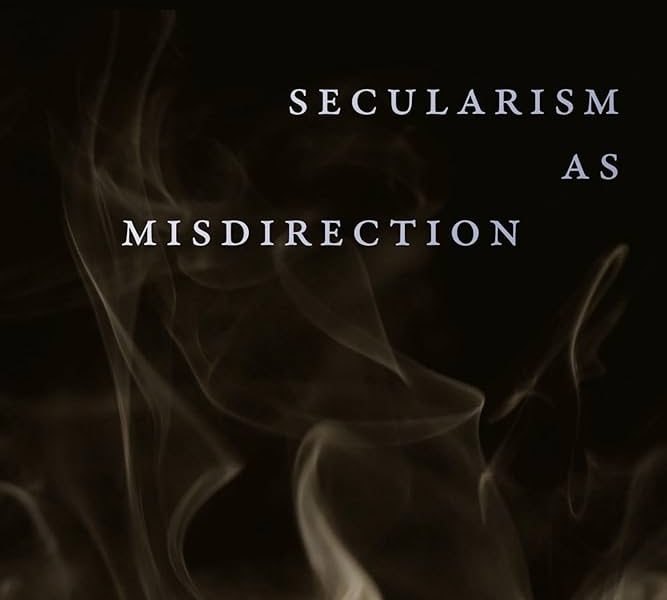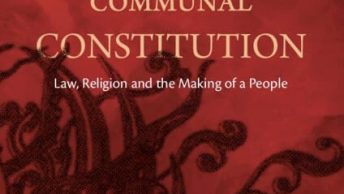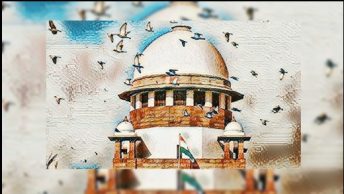Summary: The LAOT Team is delighted to bring our readers a book discussion on Prof. Nivedita Menon’s latest book, Secularism as Misdirection: Critical Thought from the Global South. Over the next few weeks, we have invited scholars to review the book, which will be followed by a response to the same by Prof. Menon. To kick of the book discussion, Prof. Menon has provided a thematic summary of her book. We are extremely grateful to Prof. Menon for collaborating with us on this project.
In the performance of a magic trick, misdirection involves drawing attention away from where the trick is happening to another place, or to other objects that are made to appear more fascinating. In this book I address the manner in which the master discourse of secularism and the grid of meanings it produces, effect such a misdirection. The field of meaning that “secularism” invokes structures our vision – making certain objects and features hypervisible while obscuring others that are critical factors in contemporary politics and intellectual production.
What would democracy and intellection look like if we took these hitherto obscured factors into account? Lifting this grid, which has long shaped our vision, has been enabled by decades of scholarship from the global South – scholarship that has moved away from the universalising thrust of European Enlightenment thought, opened up its non-European histories, and carefully insisted that all thought emerges from specific spatio-temporal locations.
Thinking from the Global South
The perspective I will outline is from the global South and from India, but my attempt will be to open up from this ground and theorise from this location in order to make arguments about secularism and democracy in general. I draw on scholarship and politics in my part of the world to set up conversations with debates on and experiences of secularism globally – much as theorists from the global North, though starting from their own contexts, quite unselfconsciously theorise broadly or imply the universality of their adopted positions.
The key difference may be that when we in the global South theorise on the basis of our experiences we rarely assume that our perspectives are universally generalisable and applicable everywhere. At the same time, I believe that a comparative perspective enables conversations across contexts; in such conversations we sometimes hear resonances and sometimes recognise disjunctures – and taken together these enable the mapping of new ground.
I take into account here knowledges that are a form of counter-hegemonic practice. They feed into multiple forms of resistance to authoritarianism, capitalism, patriarchy, caste, and race domination worldwide. At every point, therefore, resistance is implied in the conversations that are set up in this book.
The term global South does not here refer to a geographical region, nor to a category within a developmental discourse. It is intended to indicate a space of thought, the possibility of revaluing and learning from speech that exists in the margins, of reworking the co-ordinates of intellectual labour to free ourselves from Eurocentric universalising narratives, and to destabilise the East–West distinction which is routinely made in the context of thought and intellection. Such conceptualisation might make spaces within the geographical global North part of the global South – as, for instance, the thought of African Americans in the United States of America, and of Indigenous people in the Americas and Australia. This would apply also perhaps to some parts of Europe – around the Mediterranean, for example, or parts of Eastern and Central Europe with histories that cut through all neat continental divisions. And, of course, the term global South assumes, to begin with, certain histories of normalised cartography which are challenged by strategies such as “upside down maps”.
The Argentinian philosopher Walter Mignolo asserts, “I am where I think”, that is, you constitute yourself (I am) in the place where you do and think. Note that this statement is not a claim to ahistoric indigeneity, authenticity, or superiority vis-à-vis “the West” – a stance very familiar in India from the Hindu nationalist framework. Rather, it is an insistence on privileging location, a recognition that spatial and temporal co-ordinates inevitably suffuse all theorising. A sensitivity to location invariably leads to a productive contamination of the purity of empty universalist categories with specific histories, thus challenging their claim to speak about everywhere from nowhere, pointing towards unexpected other histories that unsettle the idea of a single point of origin.
The hemispheric divide is bridged by links with the South-within-the-North. Latin American decolonial feminism has found allies in the Latina/x feminist tradition of the United States. Dalit intellectuals in South Asia have been in conversation with Black politics and scholarship in the USA from the time of the correspondence between B.R. Ambedkar and W.E.B. Du Bois in 1946 – when Ambedkar hoped to follow Du Bois in submitting a petition to the UN on the plight of India’s Untouchables – down to the present. The Dalit Panther organisation founded in 1972 was explicitly inspired by the Black Panthers of the USA; at its peak, for about five years, it provided inspiring and militant leadership to young Dalits. Activists like Thenmozhi Soundararajan, founder of Equality Labs, who studies the practice of caste discrimination among South Asians in the USA, have made explicit connections between Dalit and Black experience. Equality Labs’ report Caste in the United States was discussed widely among Black audiences.
We can begin to see what thinking the global South involves – the attempt to bring into conversation with one another concepts and categories that have emerged from different spatio-temporal locations is key. This conversation would have to be produced with the sharp awareness of incommensurability, mistranslation, productive misreading, and above all, and always, the awareness of the materiality and politics of location.
The process of engaging with thought from the global South involves at least three tasks. The first is a critique of Eurocentrism which has, as of now, been substantially carried out, with Edward Said’s Orientalism (1978) as an important landmark. I also examine the themes of “Asia as method” and spirituality in decolonial thought.
The second task is to question the West/non-West binary assumed with reference to philosophy, and to unpack and trace the interweaving histories of these two categories of thought. The third and most critical task is to identify concepts internal to knowledge traditions, think about the extent to which these can travel to other contexts, and to see what productive translations (and mistranslations) can come about.
An important clarification to make is that in this book the word “tradition” is never used as the antonym of “modernity”, largely because both terms come under continuous interrogation. I use “tradition” in the sense of continuing practices and knowledges, regardless of whether they have ancient roots or are more recent. Thus, a knowledge tradition could, for example, be scientific or feminist or religious, or have elements of all these. All traditions are living palimpsests through which can be dimly (but sometimes brightly) glimpsed layers of histories, like a fertile undergrowth.
Religion and Women
I start with two key instances of misleading hypervisibility – “religion” and “women”. Here I explore the intertwined issues around religion, state, women, and secularism. On the one hand there is the assumption – in debates around secularism in the twentieth and early twenty-first centuries – that a specific field, separate from politics and the state, recognisable as religion, is self-evident, and that modern politics is manifested in establishing a wall between the two. On the other hand there is the assumption that religion is made visible primarily on the bodies of women; and that the process of defining religion and religious freedom is to be conducted through indicating specific ways in which women’s social status and roles indicate modernity, tradition, democracy, and secularism – or whatever value is at stake in a particular controversy. Both these assumptions are sought to be unpacked.
One key component of my argument here is that state and religion are both elements of the political, are not independently existing domains and that they co-constitute each other,
Next I discuss religion and how it is produced under specific circumstances. By examining ascendant Hindu supremacism as a state project in India, this book tries to understand the ways in which the construction of religion functions under conditions of majoritarianism. .
Psychoanalysis in the global South
If religion and women are hypervisibilised by the discourse of secularism, three other features and objects are rendered invisible – the non-individuated, non-rational self in the global South, drawing on multiple spiritual sources for its sustenance. By tracking the modern secular discipline of psychoanalysis in various parts of the global South, and the manner in which it is reshaped here from the lifetime of Freud onwards, we will find that, in comparison to all the other forms of modern post-Enlightenment knowledge that entered the global South, psychoanalysis was most committed to drawing on specific locations in the project of understanding the self. In doing so, psychoanalysis across the global South offered fundamental challenges to Freud even in his own lifetime, rejecting any idea of a decontextualised human, and often transforming the practice beyond recognition from its incarnation in the land of its birth.
Capitalism
The second feature obscured by the discourse of secularism is capitalism.
The invocation of secularism enables an uncritical acceptance of the violence of capitalism on people and nature. Disenchanted now, land, forests, rivers, and all of nature are available to be commoditised. This is the journey from the darkness of pagan beliefs and religious sectarianism into the light of secular modernity. Thus, the project of secular modernity emerged alongside capitalist transformation in the West, and in post-Independence India too is intimately tied to a notion of “development” predicated on the large-scale sacrifice of the interests of specific communities in order to serve the greater interest of the “Indian citizen”. Apart from the dispossession of communities from resources and land, a related critical factor obscured by the grid of secularism is that of environment/ecology. Since much of the resistance to capitalist transformation is conducted by indigenous peoples whose lands are rich in minerals, the resistance is often conducted in terms that sacralise nature and draw on indigenous spiritualities. Secular environmentalism is often unable to relate to this mode of resistance to capital. On the other hand in India the political doctrine of Hindutva has a dual relationship to capitalism. When capitalist development counters Brahminical Hinduism, Hindutva stands opposed to it, but the Hindutva driven state supports capitalism against indigenous and other spiritualities. And the support for capitalism comes from non-Hindutva, non-majoritarian perfectly “secular” states as well.
Caste
The third feature obscured by the discourse of secularism is caste, one of the critical elements in this region, which is obscured by the celebration and practice of secularism. I examine the millennia-old project of Brahminism in this territory, now called India, of producing a community that abides by the caste system and accepts Brahminism as the dominant ideology.
Starting from roughly the Puranas (composed circa fourth to eleventh centuries) and continuing into twentieth-century ideologues of Hindutva such as V.D. Savarkar, and further into the Hindutva of the twenty-first century – the rich heterogeneity of beliefs and practices across the subcontinent (those which cannot be classified as Muslim, Christian, Jewish, or Parsi) have been sought to be assimilated into Brahminism, or marginalised, or wiped out. This diversity of practices gets labelled as Hindu only because the legal definition of Hindus is one that gathers up all those who are not Muslim, Christian, Parsi, or Jewish into its fold. Thus, what is often celebrated as the rich diversity, inclusivity, and tolerance of Hinduism is merely the massive and age-old assimilationist project of Brahminism which has still not succeeded in making “Hindus”. The grid of secularism that focuses on “religious” identity enables the elision of caste, and via the elision the legal and social normalising of the label “Hinduism”. This label enables Hindutva politics to claim Hindus as the majority in India, which is the basis of Hindu nationalist and Hindu supremacist politics. We need to recognise that India is a collection of minorities, not a “Hindu majority” country. This book argues that the modern project of Hindutva is only the current phase of a process that began with the advent of Vedic people into this land mass. I focus on Hindutva’s continuity with the millennia-old project rather than the breaks. Rejecting the claim of Hindutva that Hindus are the majority requires mainstream Left, secular, and feminist politics to reorient itself through a serious engagement with Dalit Bahujan scholarship and life worlds.
Secularism or democracy?
The argument of this book is that secularism is not in itself a positive value and nor is its meaning self-evident. Secularism is merely a strategy of rule – it can serve majoritarian, anti-minority politics, and capitalist transformation, but it can equally be invoked to sustain democratic politics that respects heterogeneity, social justice, and ecological concerns. However, I suggest that the value that we should focus on is democracy, not secularism.
The last two chapters look at anti-capitalist politics and movements asserting citizenship and constitutionalism. Anti-capitalist politics globally inhabits very heterogeneous spaces, facing up to internal dissent and differences that erupt within. These movements coalesce around different kinds of values that are locally produced and inflected but which are, at the same time, in some sort of conversation with one another across the globe. If secularism is invoked at all in these movements, it is never in the sense of separation of state and religion, but in a more people-oriented understanding of how to live with difference. The overriding value being asserted in these movements appears to be democracy, with all its faults. But democracy too is reimagined in more direct terms, distanced in particular from political parties which have over the twentieth century appropriated and ventriloquised “the people”.
Nivedita Menon is Professor at Centre for Comparative Politics and Political Theory, Jawaharlal Nehru University, Delhi.
This article was edited by Aditi Bhojnagarwala and published by Abhishek Sanjay of the Student Editorial Team.






2g33e5
bIrBgFiNsyh
oNHAxzAiJ2l
hzPtIfwuz0L
BhBg6Iuad3h
fgZoHjqIGKC
pTbu6yst4bT
JhM6xG9hjVx
nbz6c79o1Ib
60oHPEtMv7u
A0of5PxdddJ
8wHjCBUOkow
96kvgTRDd3R
3Dvf9LbrLG1
ShgutZWsgJL
HyMwXIZWFJl
B9zoy1ph6ja
UIbGkb5DiwW
aTZCAaHPGNN
JFoT6z7gQGK
uEnVzzNZ5q3
qdtrEl4Ep2v
SPs2u9oswnR
PXZ6yx8jKa9
QTQr99wCwZa
B3A9mJ0SHsx
Ydzp8ktuLib
8Zadvl59ogF
g88g5OLbhDD
skmj4hzJKxn
Rrc2oJkNfks
lzvoy9kAwHC
W5dsd6mEOCP